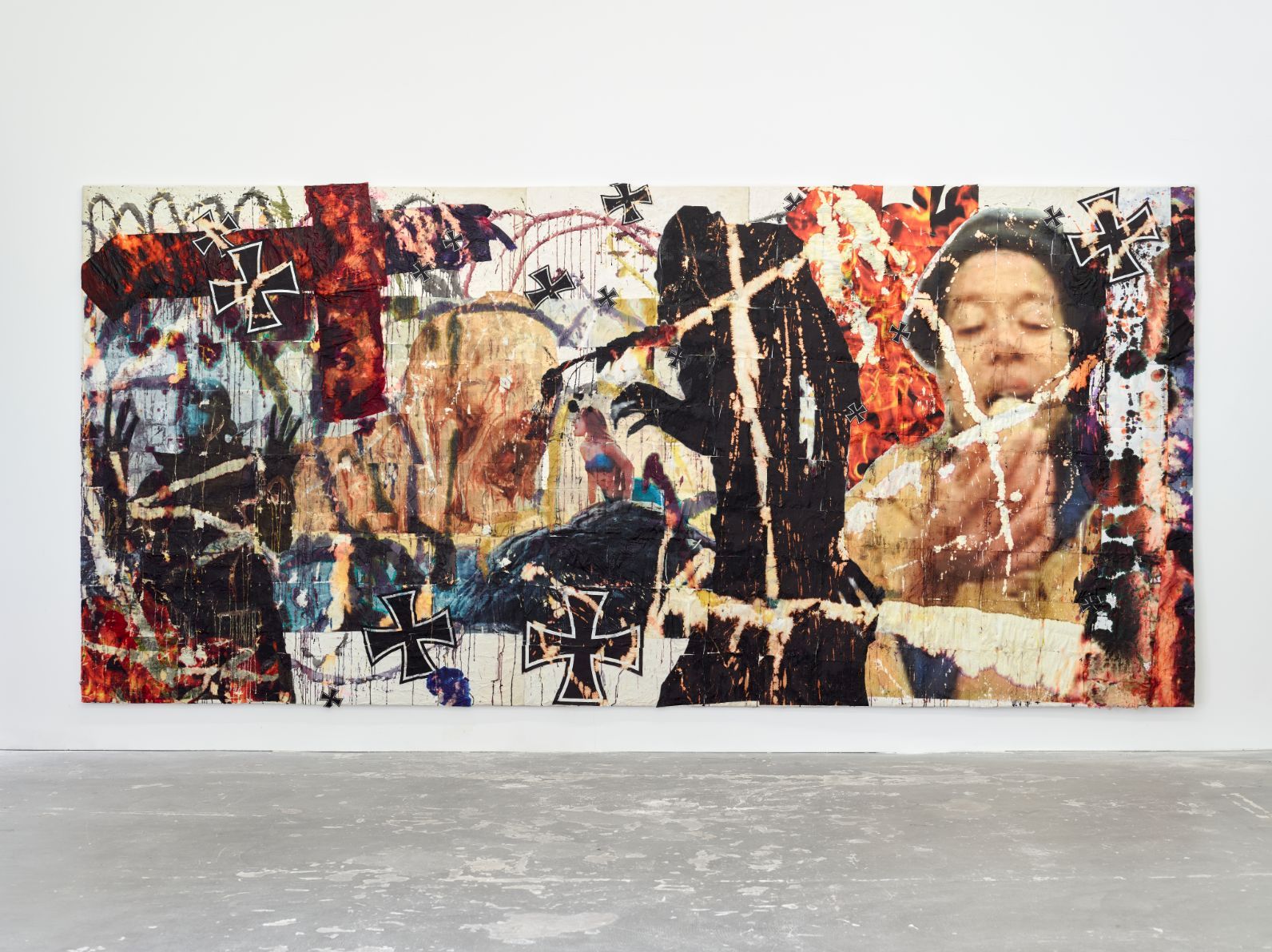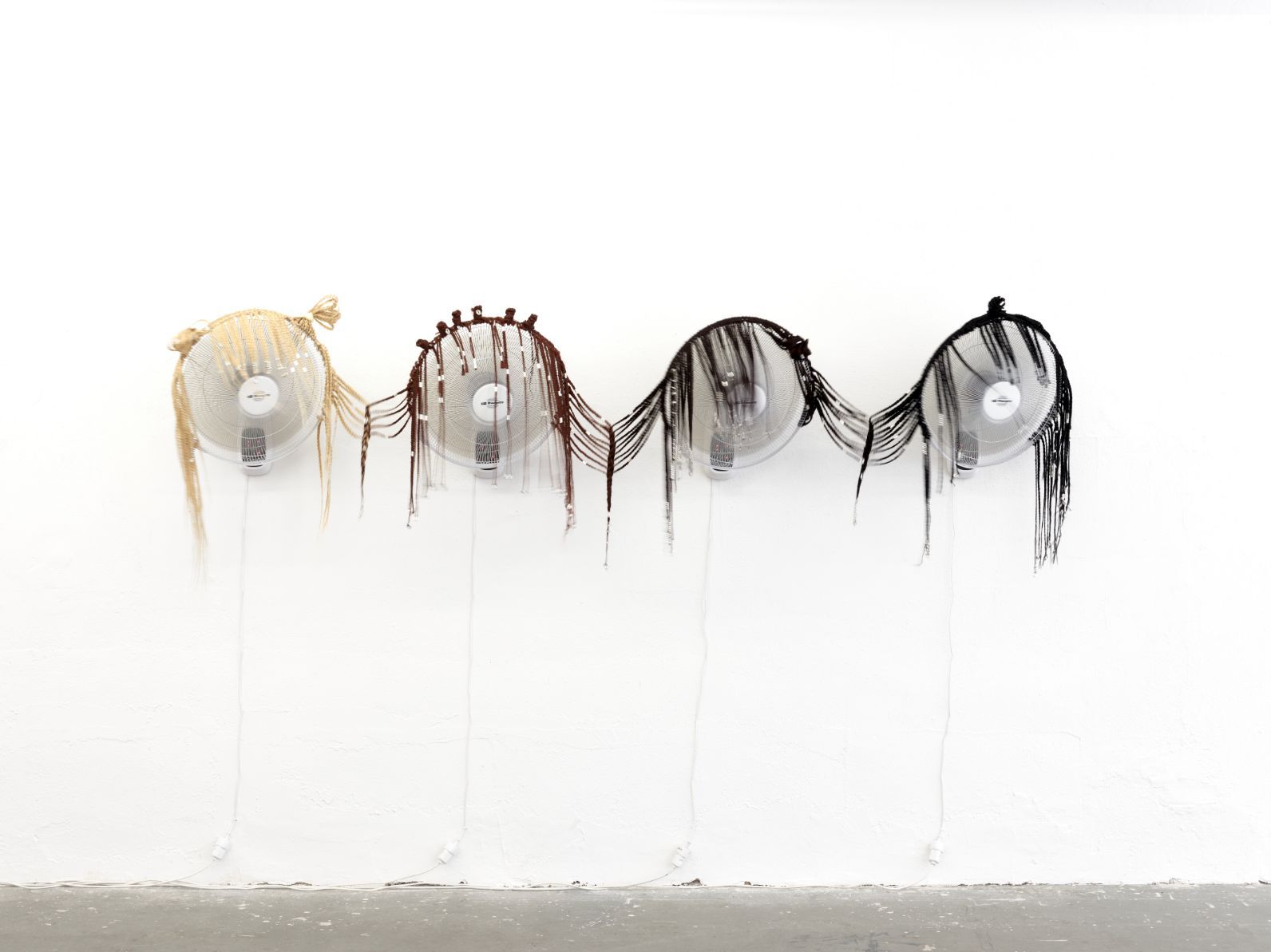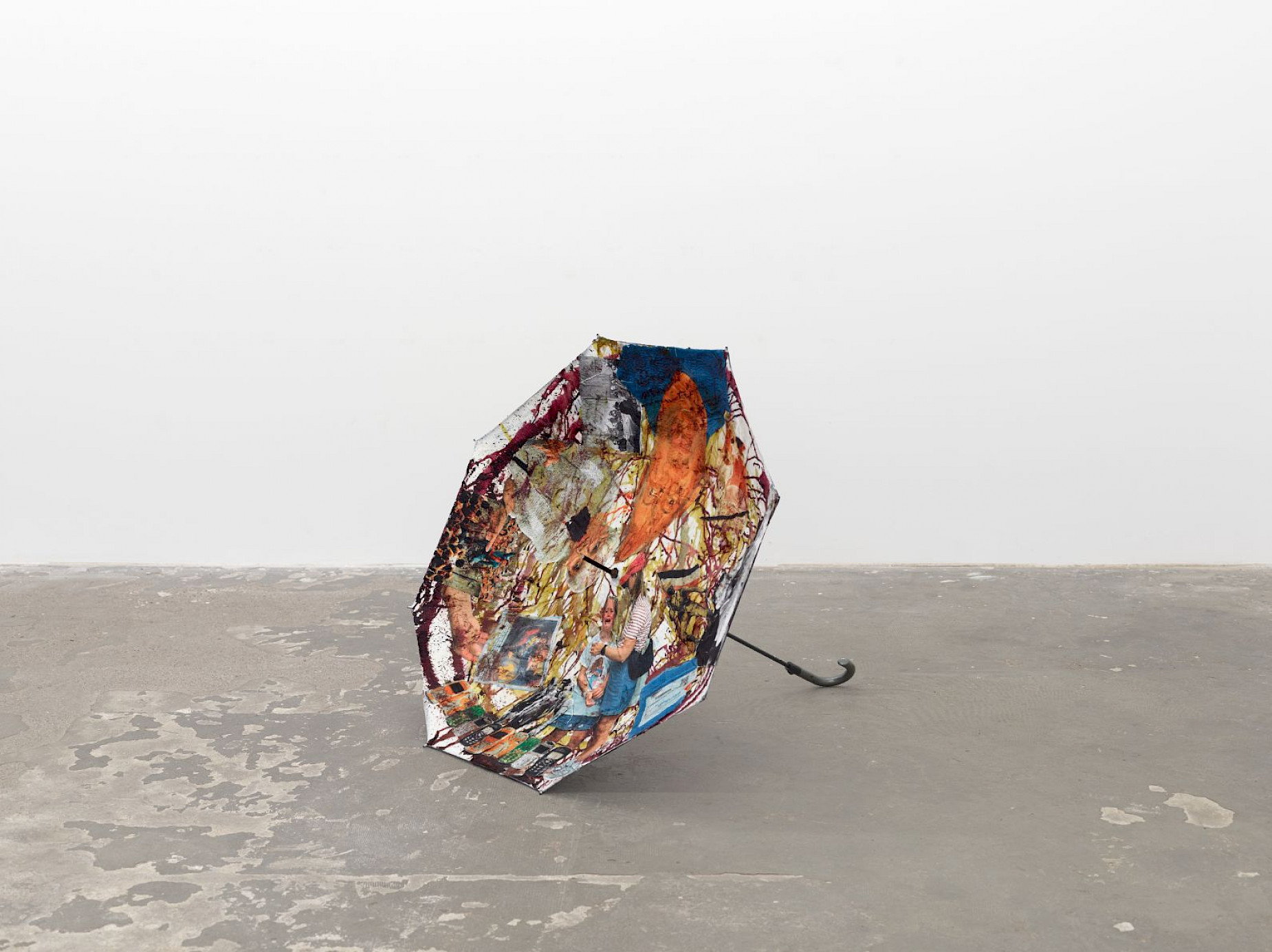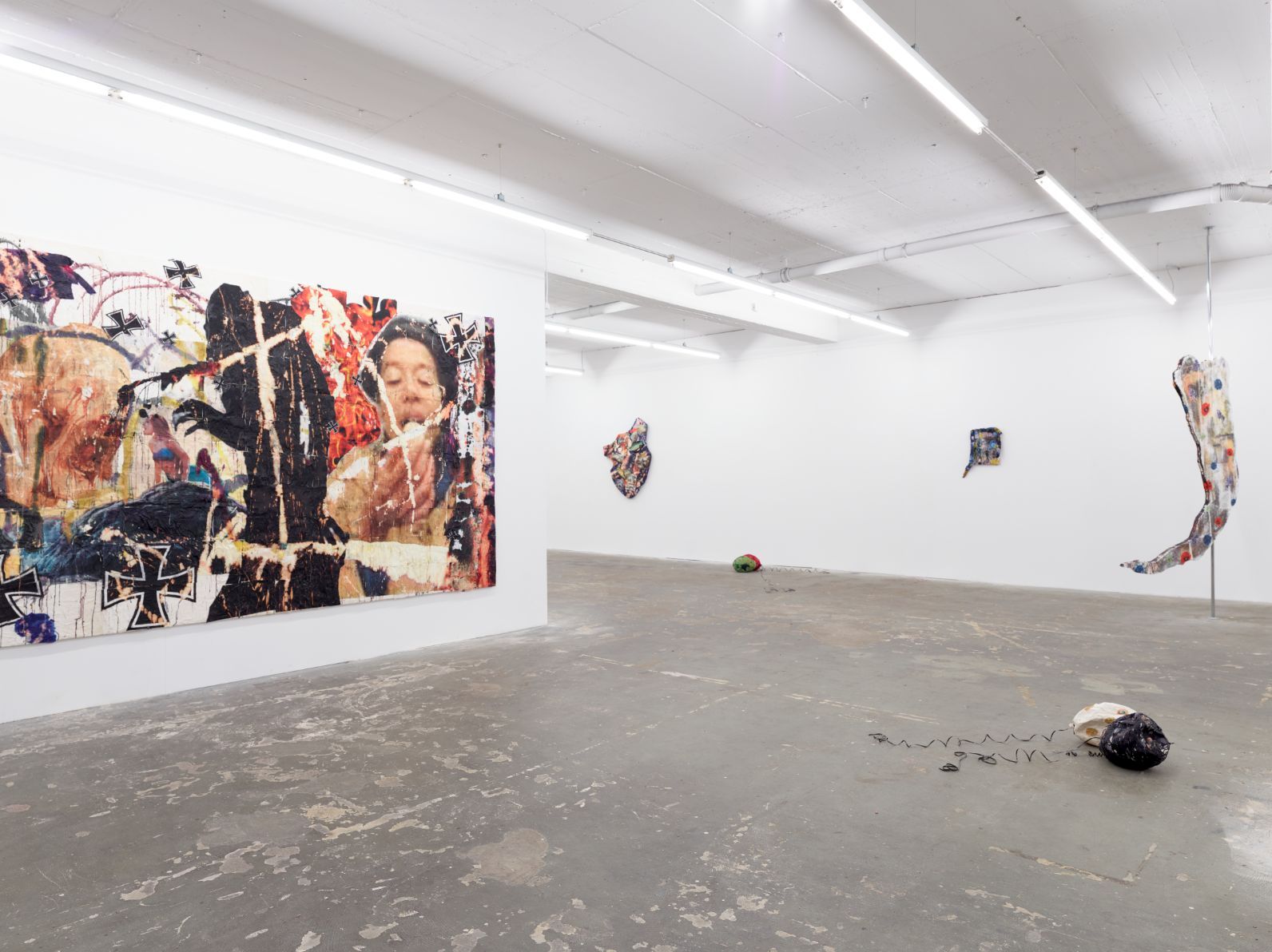
For his first solo exhibition at KOW, Monsieur Zohore transforms the gallery into a climatological field—entering Whether the Weather, four oscillating ventilators Wirbelsturm Marianne, Susanne, Sabine, Hildegard turn their heads as if in greeting. Their motors hum, their blades slice through the space, and the gallery itself becomes alive with air currents, movement, sound, and presence. Visitors are swept along in the environment these mechanical actors create, as if the works themselves are taking their temperature. The ventilators observe, approach, and engage the audience: moving portraits and hurricanes, shaping both the physical and psychic climate of the space.
The exhibition unfolds as a shifting forecast, part archive, carnival and aquarium, bringing together fragments from myth and history, children’s rhymes, German and American popular culture. It is titled after an American tongue twister that insists on endurance, doubling as a forecast for the show. MZ.30 (Diva), a talking tree, queers the experience of weather, asking, “How will she treat you?”. As Christina Sharpe writes in In the Wake, “weather is the totality of our environments.” Weathering–as Sharpe defines it– names the ongoing condition of living within anti-Blackness: the atmospheric pressure that bears on Black life, the storm one must endure and improvise within. Zohore holds this conceptual frame as diagnosis and demand: recognising supremacy as a total environment, twisting exoticizing gazes into humor, weathering whiteness and turning it inside out.
The artist works like a documentarist of the everyday, his practice is an audit of culture: historical facts, mass-produced objects, bureaucratic tokens, and personal sightings are rearranged into provocative constellations. Paper towels, for instance, register as essays that absorb, record, and communicate the artist's process. Digital images, collected ephemera, and quotidian objects are presented with a signature wit, inviting play and participation.
In Die!, Meerjungfrau, 1922–2025, Zohore assembles Nosferatu across three eras, Halle Bailey’s Black Little Mermaid, May Ayim, and the Iron Cross. Vampires, mermaids, and poets occupy thresholds where the human is narrated as monstrous or marvelous depending on who looks. In Fischers Fritze fischt frische Fische… a singsong German tongue-twister frays into violence: its playful cadence collapses beside an 1805 engraving of a slave ship, lists of invasive fish species, and Achenbach’s Romantic seascapes. Innocence in language masks a history of German colonial violence; “invasive” becomes a recurring motif, ecological, linguistic, and cultural. In these works, collage as method presses disparate climates together.
Other works test national icons under new atmospheric pressure. Eine unbequeme Wahrheitplaces Friedrich’s Romanticism beside Kehinde Wiley’s lush Prelude (Babacar Mané), framed by football fans in blackface and the fallout of Mesut Özil’s resignation. In Bunter Hund, Afro-German cultural figures like Arabella Kiesbauer, Nelson Müller, Theodor Wonja Michael appear alongside the artist enclosed in a dog cage. To be a “Bunter Hund” (colourful dog) is to be celebrated and exoticized at once, absorbed into national imagination while still marked as other. Reflecting microaggressions experienced in the cultural climate of Berlin, language itself becomes weather, mistranslation a persistent fog.
In an audio work, made in collaboration with the artist's longtime collaborator, composer Joshua Coyne, breath is caught and released, never quite arriving, echoing environmental collapse within the refrain of “Berliner Luft”. Air itself becomes an archive of cultural memory. Elsewhere, humor sharpens critique: Der Geschmacklose swirls Loriot, Pumuckl, Werner, Markus Söder, and Andreas Gursky’s Rhein II. Taste and tastelessness collapse until neither holds, undermining hierarchies of value. Like a sudden shift in weather, cultural appropriation is teased as a form of invasive flooding.
Across the exhibition, traces of German Romanticism are twisted into playful landscapes alive with voices, references, and figures. Zohore constructs crowded stages of association, generating his own mythologies of weathering through allegory, humor, and site-specific observation.
To step into Whether the Weather is to feel multiple atmospheres enclosed together: fun and unsettling, lyrical and cutting. History arrives not as past event but as atmosphere, staining surfaces, saturating lungs, shaping how bodies move. We are invited to brace the weather and imagine new forecasts.
––
Monsieur Zohore (b. 1993, Potomac, MD) is an Ivorian-American artist whose practice is rooted in the politics of transfiguration. Working across performance, sculpture, painting, video, and installation, Zohore stages acts of consumption, cleaning, and care as complex rituals—spaces where meaning is made, exhausted, and remade.
Zohore’s work, marked by an attraction to cleverness, sinister undertones, and heartbreaking depth, draws from art history, queer theory, postcolonial thought, and popular culture. His pieces move fluently between devotional humor and bureaucratic horror, revealing how intimacy and erasure operate at the level of form. At the center of his practice is an inquiry into the personification of objects and the objectification of people— how bodies are rendered useful, disposable, or divine.
He treats domestic labor not as metaphor, but as medium. His recurring use of humble or overlooked materials—such as paper towels, municipal infrastructure, surplus ephemera, and quotidian experiences—illuminates how systems of power permeate the everyday. Zohore’s installations and performances do not aim to reflect reality, but to rupture it—gently, deliberately, and without apology.
Through a lush vocabulary of repetition, refusal, and ritual, his work foregrounds labor as both sacrament and critique. He invites audiences to consider what transformation looks like when nothing is stable and everything is at stake.
Text by Naima Hassan






